Organizational Behavior Report: Change Implementation and Leadership
VerifiedAdded on 2022/11/25
|6
|1925
|56
Report
AI Summary
This report, prepared by a trainee HR consultant, examines the complexities of organizational change. It begins by identifying the drivers of change, both internal and external, that necessitate adjustments within businesses. The report then delves into the reasons behind employee resistance to change, highlighting factors like job security concerns and miscommunication. A significant portion of the report focuses on applying Kurt Lewin's three-stage change model (unfreezing, changing, refreezing) to guide the implementation of change initiatives. The report also evaluates various leadership styles, including democratic, autocratic, and laissez-faire, and how they can be effectively employed at each stage of Lewin's model to mitigate resistance and foster successful change. References are provided from relevant academic journals and publications to support the analysis.
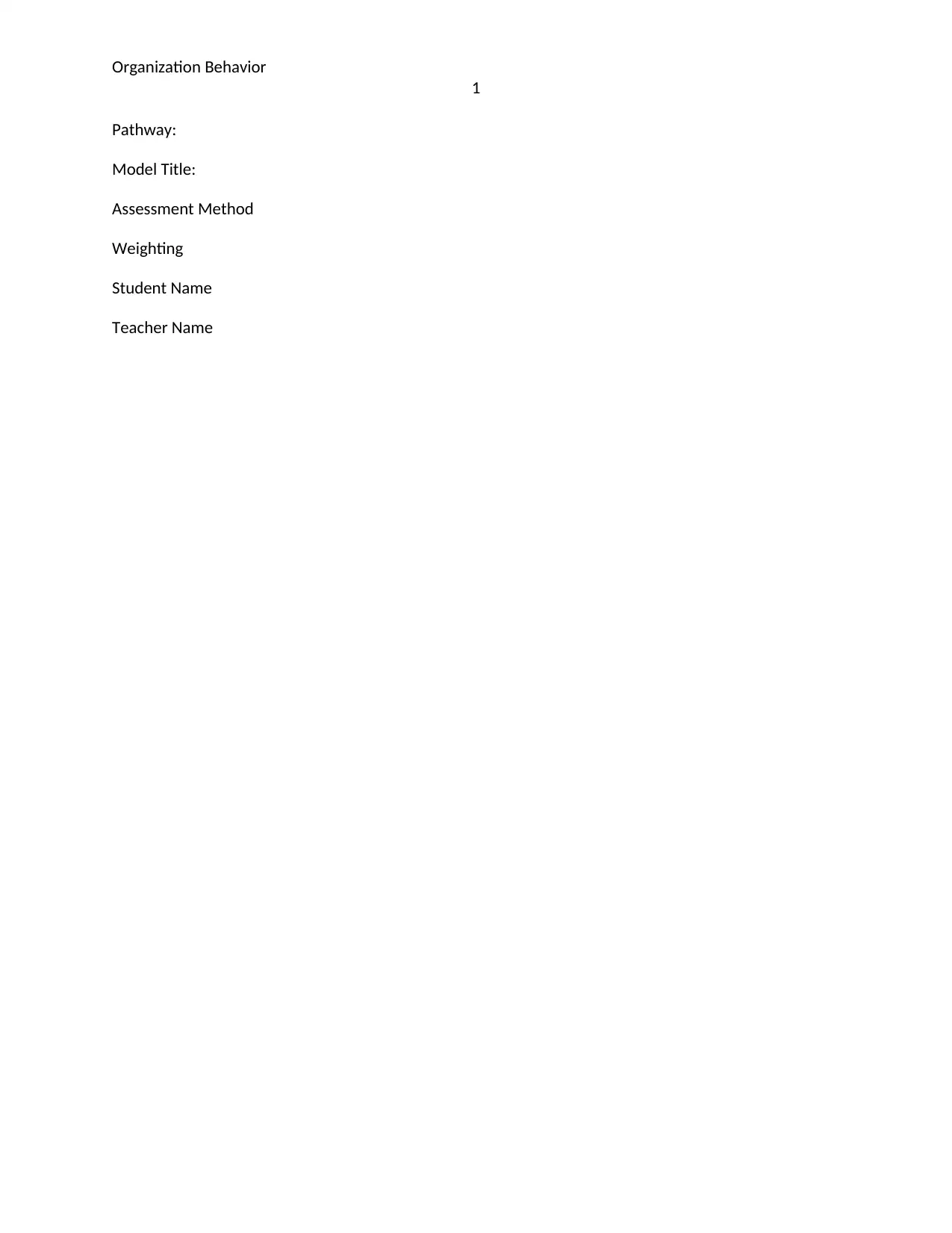
Organization Behavior
1
Pathway:
Model Title:
Assessment Method
Weighting
Student Name
Teacher Name
1
Pathway:
Model Title:
Assessment Method
Weighting
Student Name
Teacher Name
Paraphrase This Document
Need a fresh take? Get an instant paraphrase of this document with our AI Paraphraser
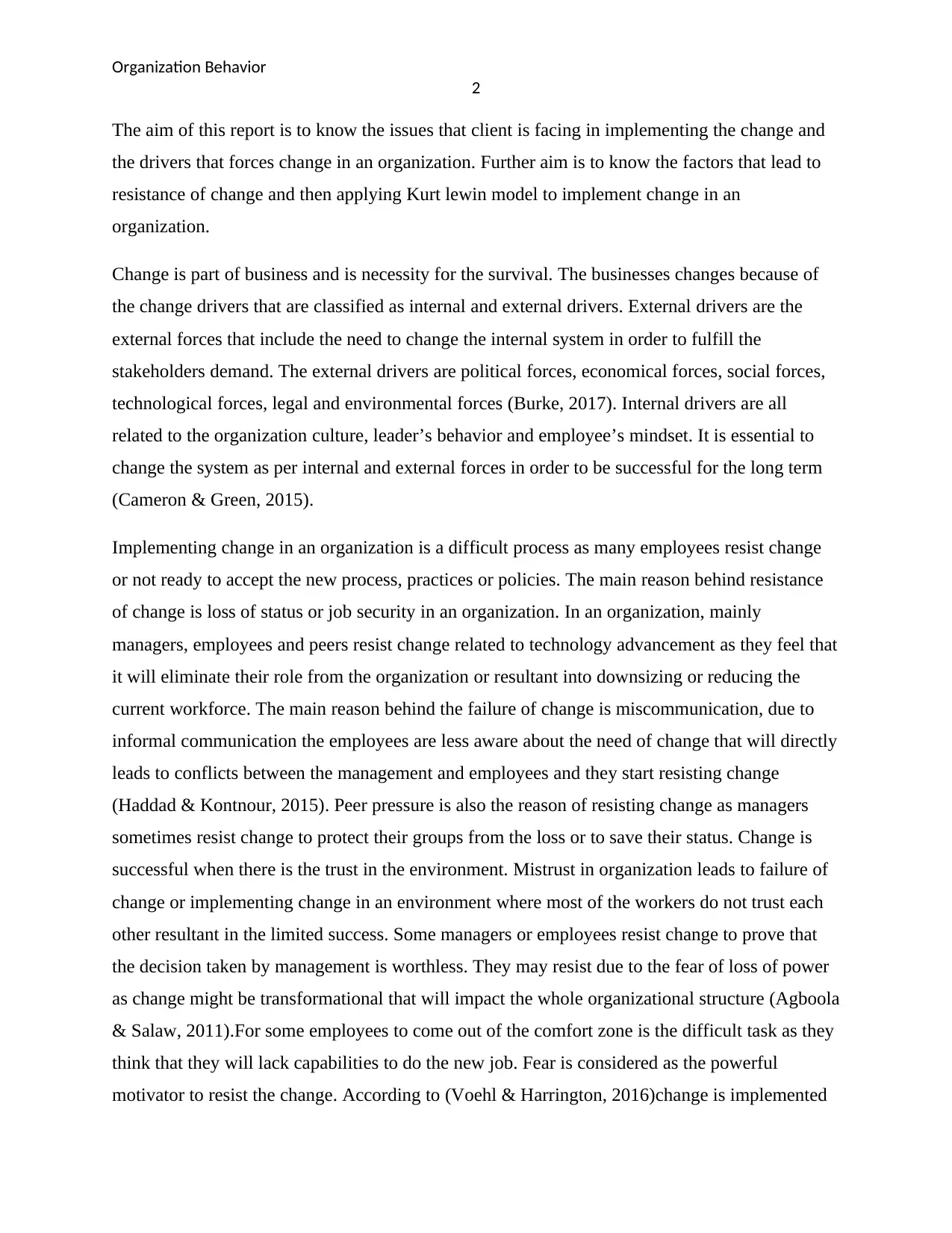
Organization Behavior
2
The aim of this report is to know the issues that client is facing in implementing the change and
the drivers that forces change in an organization. Further aim is to know the factors that lead to
resistance of change and then applying Kurt lewin model to implement change in an
organization.
Change is part of business and is necessity for the survival. The businesses changes because of
the change drivers that are classified as internal and external drivers. External drivers are the
external forces that include the need to change the internal system in order to fulfill the
stakeholders demand. The external drivers are political forces, economical forces, social forces,
technological forces, legal and environmental forces (Burke, 2017). Internal drivers are all
related to the organization culture, leader’s behavior and employee’s mindset. It is essential to
change the system as per internal and external forces in order to be successful for the long term
(Cameron & Green, 2015).
Implementing change in an organization is a difficult process as many employees resist change
or not ready to accept the new process, practices or policies. The main reason behind resistance
of change is loss of status or job security in an organization. In an organization, mainly
managers, employees and peers resist change related to technology advancement as they feel that
it will eliminate their role from the organization or resultant into downsizing or reducing the
current workforce. The main reason behind the failure of change is miscommunication, due to
informal communication the employees are less aware about the need of change that will directly
leads to conflicts between the management and employees and they start resisting change
(Haddad & Kontnour, 2015). Peer pressure is also the reason of resisting change as managers
sometimes resist change to protect their groups from the loss or to save their status. Change is
successful when there is the trust in the environment. Mistrust in organization leads to failure of
change or implementing change in an environment where most of the workers do not trust each
other resultant in the limited success. Some managers or employees resist change to prove that
the decision taken by management is worthless. They may resist due to the fear of loss of power
as change might be transformational that will impact the whole organizational structure (Agboola
& Salaw, 2011).For some employees to come out of the comfort zone is the difficult task as they
think that they will lack capabilities to do the new job. Fear is considered as the powerful
motivator to resist the change. According to (Voehl & Harrington, 2016)change is implemented
2
The aim of this report is to know the issues that client is facing in implementing the change and
the drivers that forces change in an organization. Further aim is to know the factors that lead to
resistance of change and then applying Kurt lewin model to implement change in an
organization.
Change is part of business and is necessity for the survival. The businesses changes because of
the change drivers that are classified as internal and external drivers. External drivers are the
external forces that include the need to change the internal system in order to fulfill the
stakeholders demand. The external drivers are political forces, economical forces, social forces,
technological forces, legal and environmental forces (Burke, 2017). Internal drivers are all
related to the organization culture, leader’s behavior and employee’s mindset. It is essential to
change the system as per internal and external forces in order to be successful for the long term
(Cameron & Green, 2015).
Implementing change in an organization is a difficult process as many employees resist change
or not ready to accept the new process, practices or policies. The main reason behind resistance
of change is loss of status or job security in an organization. In an organization, mainly
managers, employees and peers resist change related to technology advancement as they feel that
it will eliminate their role from the organization or resultant into downsizing or reducing the
current workforce. The main reason behind the failure of change is miscommunication, due to
informal communication the employees are less aware about the need of change that will directly
leads to conflicts between the management and employees and they start resisting change
(Haddad & Kontnour, 2015). Peer pressure is also the reason of resisting change as managers
sometimes resist change to protect their groups from the loss or to save their status. Change is
successful when there is the trust in the environment. Mistrust in organization leads to failure of
change or implementing change in an environment where most of the workers do not trust each
other resultant in the limited success. Some managers or employees resist change to prove that
the decision taken by management is worthless. They may resist due to the fear of loss of power
as change might be transformational that will impact the whole organizational structure (Agboola
& Salaw, 2011).For some employees to come out of the comfort zone is the difficult task as they
think that they will lack capabilities to do the new job. Fear is considered as the powerful
motivator to resist the change. According to (Voehl & Harrington, 2016)change is implemented
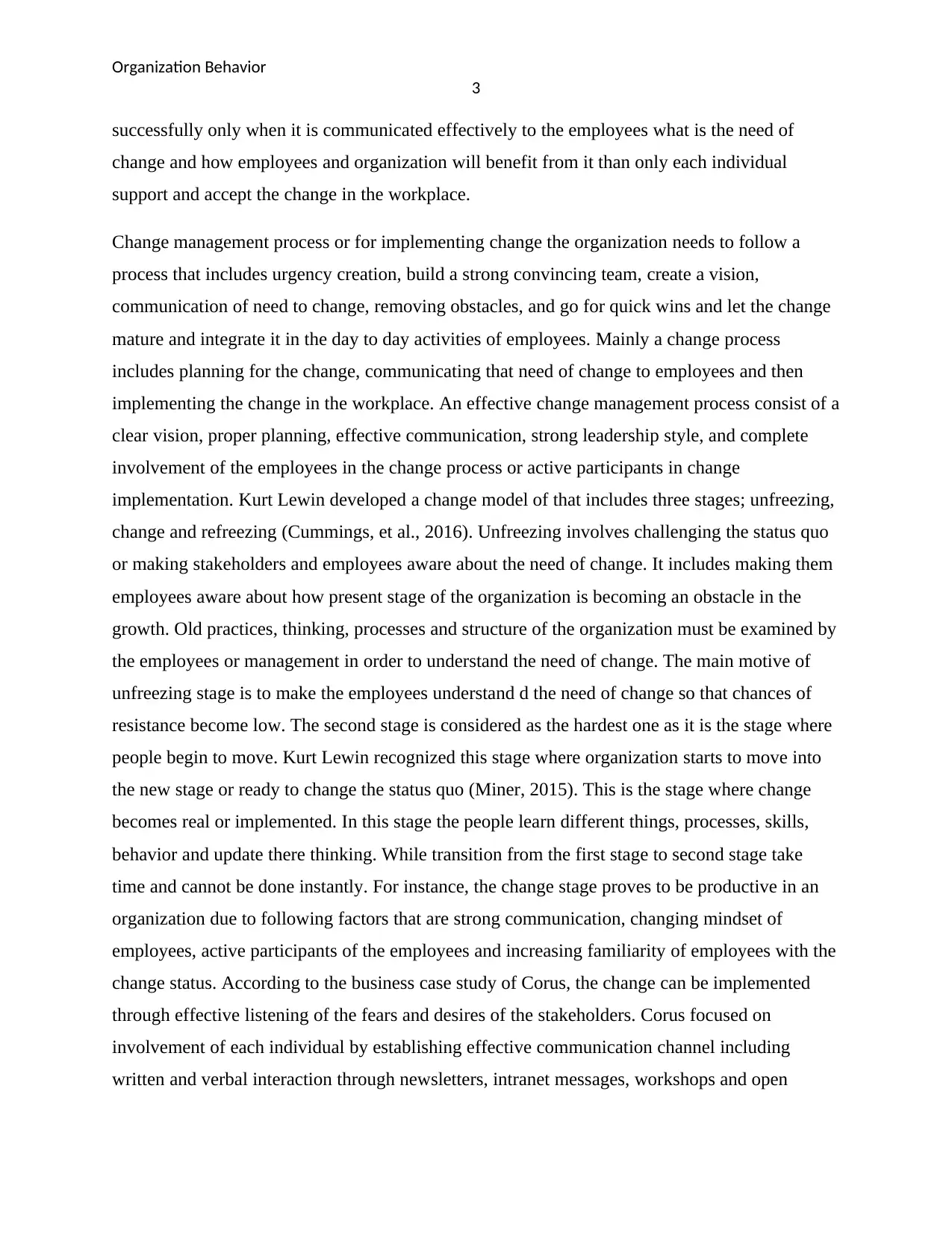
Organization Behavior
3
successfully only when it is communicated effectively to the employees what is the need of
change and how employees and organization will benefit from it than only each individual
support and accept the change in the workplace.
Change management process or for implementing change the organization needs to follow a
process that includes urgency creation, build a strong convincing team, create a vision,
communication of need to change, removing obstacles, and go for quick wins and let the change
mature and integrate it in the day to day activities of employees. Mainly a change process
includes planning for the change, communicating that need of change to employees and then
implementing the change in the workplace. An effective change management process consist of a
clear vision, proper planning, effective communication, strong leadership style, and complete
involvement of the employees in the change process or active participants in change
implementation. Kurt Lewin developed a change model of that includes three stages; unfreezing,
change and refreezing (Cummings, et al., 2016). Unfreezing involves challenging the status quo
or making stakeholders and employees aware about the need of change. It includes making them
employees aware about how present stage of the organization is becoming an obstacle in the
growth. Old practices, thinking, processes and structure of the organization must be examined by
the employees or management in order to understand the need of change. The main motive of
unfreezing stage is to make the employees understand d the need of change so that chances of
resistance become low. The second stage is considered as the hardest one as it is the stage where
people begin to move. Kurt Lewin recognized this stage where organization starts to move into
the new stage or ready to change the status quo (Miner, 2015). This is the stage where change
becomes real or implemented. In this stage the people learn different things, processes, skills,
behavior and update there thinking. While transition from the first stage to second stage take
time and cannot be done instantly. For instance, the change stage proves to be productive in an
organization due to following factors that are strong communication, changing mindset of
employees, active participants of the employees and increasing familiarity of employees with the
change status. According to the business case study of Corus, the change can be implemented
through effective listening of the fears and desires of the stakeholders. Corus focused on
involvement of each individual by establishing effective communication channel including
written and verbal interaction through newsletters, intranet messages, workshops and open
3
successfully only when it is communicated effectively to the employees what is the need of
change and how employees and organization will benefit from it than only each individual
support and accept the change in the workplace.
Change management process or for implementing change the organization needs to follow a
process that includes urgency creation, build a strong convincing team, create a vision,
communication of need to change, removing obstacles, and go for quick wins and let the change
mature and integrate it in the day to day activities of employees. Mainly a change process
includes planning for the change, communicating that need of change to employees and then
implementing the change in the workplace. An effective change management process consist of a
clear vision, proper planning, effective communication, strong leadership style, and complete
involvement of the employees in the change process or active participants in change
implementation. Kurt Lewin developed a change model of that includes three stages; unfreezing,
change and refreezing (Cummings, et al., 2016). Unfreezing involves challenging the status quo
or making stakeholders and employees aware about the need of change. It includes making them
employees aware about how present stage of the organization is becoming an obstacle in the
growth. Old practices, thinking, processes and structure of the organization must be examined by
the employees or management in order to understand the need of change. The main motive of
unfreezing stage is to make the employees understand d the need of change so that chances of
resistance become low. The second stage is considered as the hardest one as it is the stage where
people begin to move. Kurt Lewin recognized this stage where organization starts to move into
the new stage or ready to change the status quo (Miner, 2015). This is the stage where change
becomes real or implemented. In this stage the people learn different things, processes, skills,
behavior and update there thinking. While transition from the first stage to second stage take
time and cannot be done instantly. For instance, the change stage proves to be productive in an
organization due to following factors that are strong communication, changing mindset of
employees, active participants of the employees and increasing familiarity of employees with the
change status. According to the business case study of Corus, the change can be implemented
through effective listening of the fears and desires of the stakeholders. Corus focused on
involvement of each individual by establishing effective communication channel including
written and verbal interaction through newsletters, intranet messages, workshops and open
⊘ This is a preview!⊘
Do you want full access?
Subscribe today to unlock all pages.

Trusted by 1+ million students worldwide
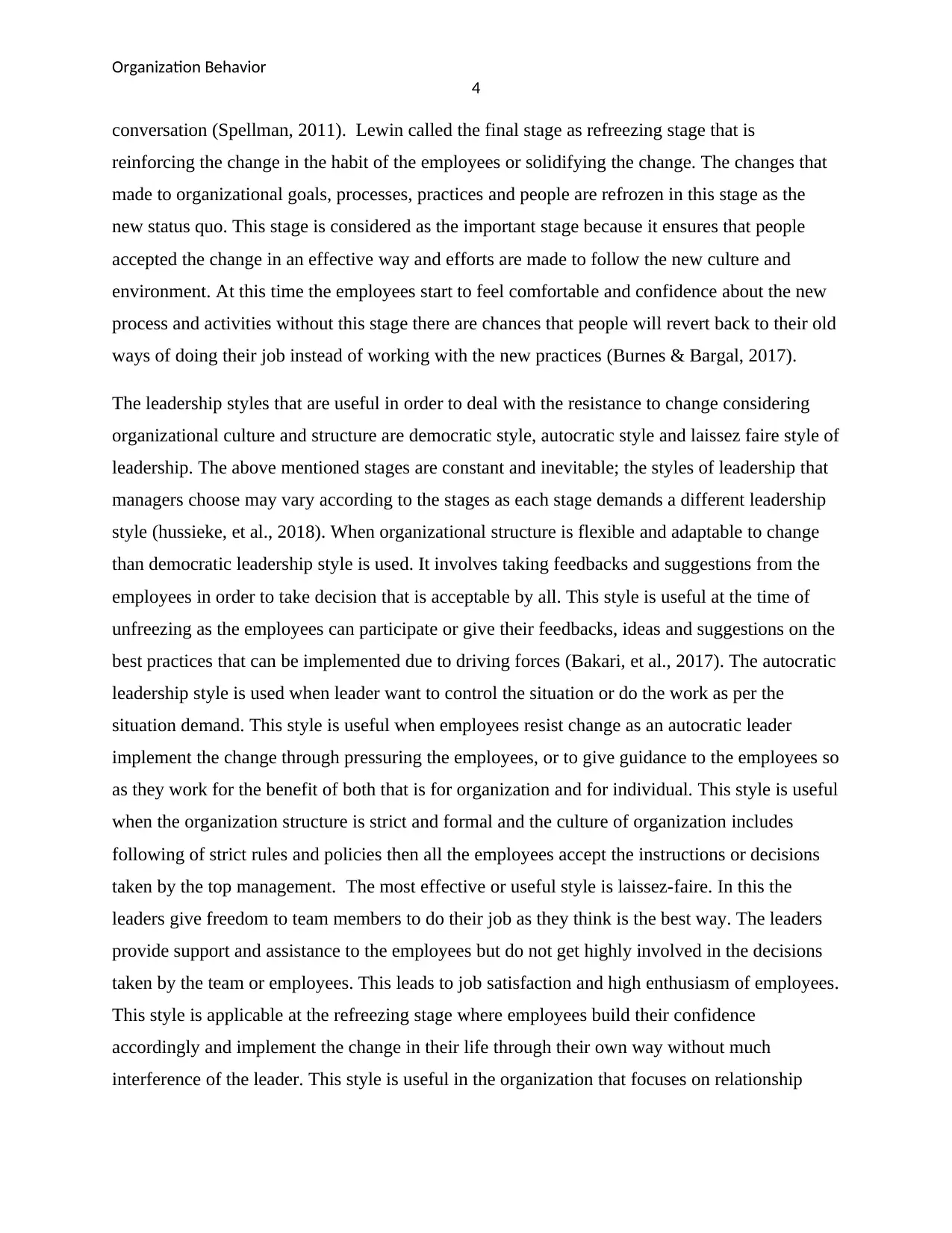
Organization Behavior
4
conversation (Spellman, 2011). Lewin called the final stage as refreezing stage that is
reinforcing the change in the habit of the employees or solidifying the change. The changes that
made to organizational goals, processes, practices and people are refrozen in this stage as the
new status quo. This stage is considered as the important stage because it ensures that people
accepted the change in an effective way and efforts are made to follow the new culture and
environment. At this time the employees start to feel comfortable and confidence about the new
process and activities without this stage there are chances that people will revert back to their old
ways of doing their job instead of working with the new practices (Burnes & Bargal, 2017).
The leadership styles that are useful in order to deal with the resistance to change considering
organizational culture and structure are democratic style, autocratic style and laissez faire style of
leadership. The above mentioned stages are constant and inevitable; the styles of leadership that
managers choose may vary according to the stages as each stage demands a different leadership
style (hussieke, et al., 2018). When organizational structure is flexible and adaptable to change
than democratic leadership style is used. It involves taking feedbacks and suggestions from the
employees in order to take decision that is acceptable by all. This style is useful at the time of
unfreezing as the employees can participate or give their feedbacks, ideas and suggestions on the
best practices that can be implemented due to driving forces (Bakari, et al., 2017). The autocratic
leadership style is used when leader want to control the situation or do the work as per the
situation demand. This style is useful when employees resist change as an autocratic leader
implement the change through pressuring the employees, or to give guidance to the employees so
as they work for the benefit of both that is for organization and for individual. This style is useful
when the organization structure is strict and formal and the culture of organization includes
following of strict rules and policies then all the employees accept the instructions or decisions
taken by the top management. The most effective or useful style is laissez-faire. In this the
leaders give freedom to team members to do their job as they think is the best way. The leaders
provide support and assistance to the employees but do not get highly involved in the decisions
taken by the team or employees. This leads to job satisfaction and high enthusiasm of employees.
This style is applicable at the refreezing stage where employees build their confidence
accordingly and implement the change in their life through their own way without much
interference of the leader. This style is useful in the organization that focuses on relationship
4
conversation (Spellman, 2011). Lewin called the final stage as refreezing stage that is
reinforcing the change in the habit of the employees or solidifying the change. The changes that
made to organizational goals, processes, practices and people are refrozen in this stage as the
new status quo. This stage is considered as the important stage because it ensures that people
accepted the change in an effective way and efforts are made to follow the new culture and
environment. At this time the employees start to feel comfortable and confidence about the new
process and activities without this stage there are chances that people will revert back to their old
ways of doing their job instead of working with the new practices (Burnes & Bargal, 2017).
The leadership styles that are useful in order to deal with the resistance to change considering
organizational culture and structure are democratic style, autocratic style and laissez faire style of
leadership. The above mentioned stages are constant and inevitable; the styles of leadership that
managers choose may vary according to the stages as each stage demands a different leadership
style (hussieke, et al., 2018). When organizational structure is flexible and adaptable to change
than democratic leadership style is used. It involves taking feedbacks and suggestions from the
employees in order to take decision that is acceptable by all. This style is useful at the time of
unfreezing as the employees can participate or give their feedbacks, ideas and suggestions on the
best practices that can be implemented due to driving forces (Bakari, et al., 2017). The autocratic
leadership style is used when leader want to control the situation or do the work as per the
situation demand. This style is useful when employees resist change as an autocratic leader
implement the change through pressuring the employees, or to give guidance to the employees so
as they work for the benefit of both that is for organization and for individual. This style is useful
when the organization structure is strict and formal and the culture of organization includes
following of strict rules and policies then all the employees accept the instructions or decisions
taken by the top management. The most effective or useful style is laissez-faire. In this the
leaders give freedom to team members to do their job as they think is the best way. The leaders
provide support and assistance to the employees but do not get highly involved in the decisions
taken by the team or employees. This leads to job satisfaction and high enthusiasm of employees.
This style is applicable at the refreezing stage where employees build their confidence
accordingly and implement the change in their life through their own way without much
interference of the leader. This style is useful in the organization that focuses on relationship
Paraphrase This Document
Need a fresh take? Get an instant paraphrase of this document with our AI Paraphraser
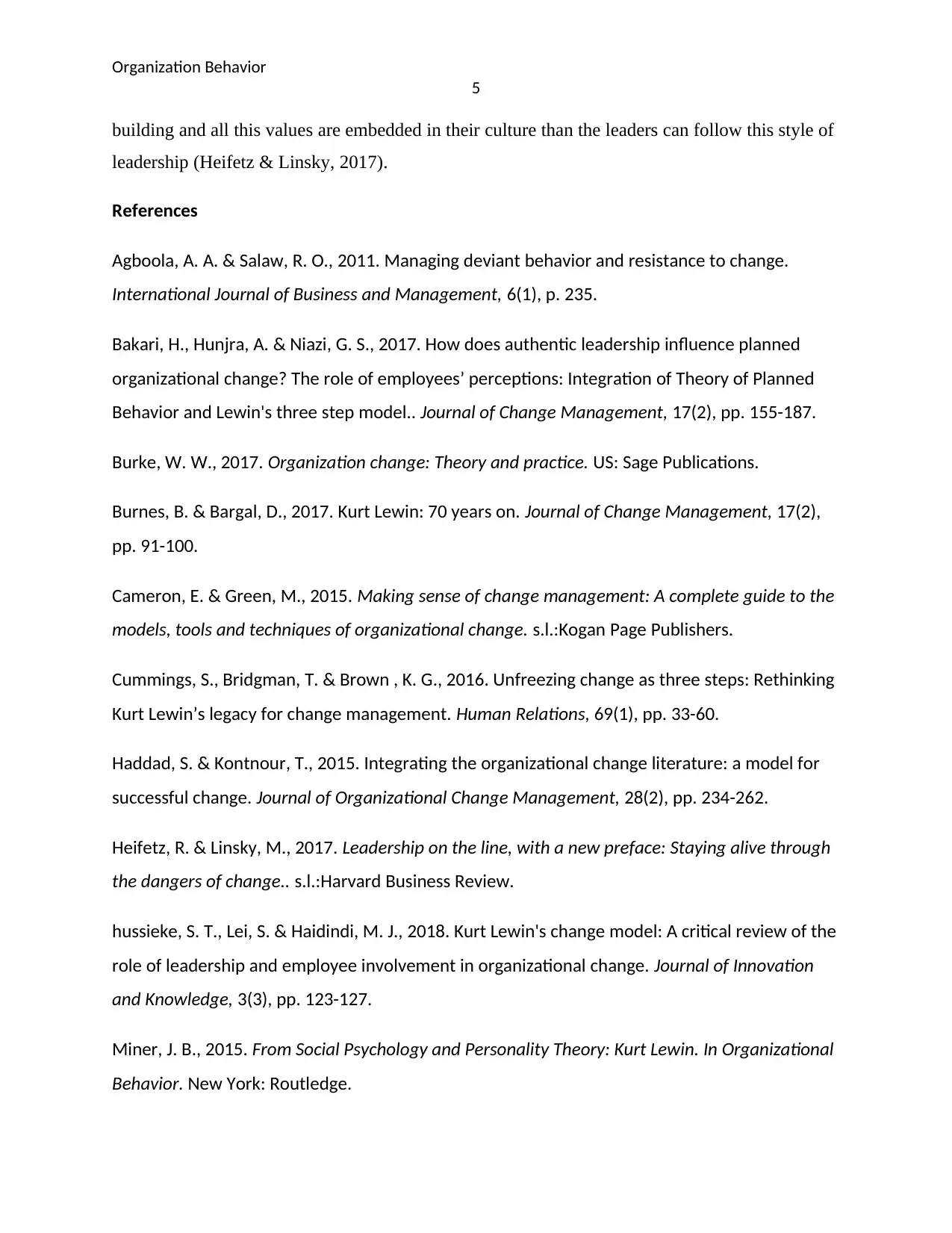
Organization Behavior
5
building and all this values are embedded in their culture than the leaders can follow this style of
leadership (Heifetz & Linsky, 2017).
References
Agboola, A. A. & Salaw, R. O., 2011. Managing deviant behavior and resistance to change.
International Journal of Business and Management, 6(1), p. 235.
Bakari, H., Hunjra, A. & Niazi, G. S., 2017. How does authentic leadership influence planned
organizational change? The role of employees’ perceptions: Integration of Theory of Planned
Behavior and Lewin's three step model.. Journal of Change Management, 17(2), pp. 155-187.
Burke, W. W., 2017. Organization change: Theory and practice. US: Sage Publications.
Burnes, B. & Bargal, D., 2017. Kurt Lewin: 70 years on. Journal of Change Management, 17(2),
pp. 91-100.
Cameron, E. & Green, M., 2015. Making sense of change management: A complete guide to the
models, tools and techniques of organizational change. s.l.:Kogan Page Publishers.
Cummings, S., Bridgman, T. & Brown , K. G., 2016. Unfreezing change as three steps: Rethinking
Kurt Lewin’s legacy for change management. Human Relations, 69(1), pp. 33-60.
Haddad, S. & Kontnour, T., 2015. Integrating the organizational change literature: a model for
successful change. Journal of Organizational Change Management, 28(2), pp. 234-262.
Heifetz, R. & Linsky, M., 2017. Leadership on the line, with a new preface: Staying alive through
the dangers of change.. s.l.:Harvard Business Review.
hussieke, S. T., Lei, S. & Haidindi, M. J., 2018. Kurt Lewin's change model: A critical review of the
role of leadership and employee involvement in organizational change. Journal of Innovation
and Knowledge, 3(3), pp. 123-127.
Miner, J. B., 2015. From Social Psychology and Personality Theory: Kurt Lewin. In Organizational
Behavior. New York: Routledge.
5
building and all this values are embedded in their culture than the leaders can follow this style of
leadership (Heifetz & Linsky, 2017).
References
Agboola, A. A. & Salaw, R. O., 2011. Managing deviant behavior and resistance to change.
International Journal of Business and Management, 6(1), p. 235.
Bakari, H., Hunjra, A. & Niazi, G. S., 2017. How does authentic leadership influence planned
organizational change? The role of employees’ perceptions: Integration of Theory of Planned
Behavior and Lewin's three step model.. Journal of Change Management, 17(2), pp. 155-187.
Burke, W. W., 2017. Organization change: Theory and practice. US: Sage Publications.
Burnes, B. & Bargal, D., 2017. Kurt Lewin: 70 years on. Journal of Change Management, 17(2),
pp. 91-100.
Cameron, E. & Green, M., 2015. Making sense of change management: A complete guide to the
models, tools and techniques of organizational change. s.l.:Kogan Page Publishers.
Cummings, S., Bridgman, T. & Brown , K. G., 2016. Unfreezing change as three steps: Rethinking
Kurt Lewin’s legacy for change management. Human Relations, 69(1), pp. 33-60.
Haddad, S. & Kontnour, T., 2015. Integrating the organizational change literature: a model for
successful change. Journal of Organizational Change Management, 28(2), pp. 234-262.
Heifetz, R. & Linsky, M., 2017. Leadership on the line, with a new preface: Staying alive through
the dangers of change.. s.l.:Harvard Business Review.
hussieke, S. T., Lei, S. & Haidindi, M. J., 2018. Kurt Lewin's change model: A critical review of the
role of leadership and employee involvement in organizational change. Journal of Innovation
and Knowledge, 3(3), pp. 123-127.
Miner, J. B., 2015. From Social Psychology and Personality Theory: Kurt Lewin. In Organizational
Behavior. New York: Routledge.
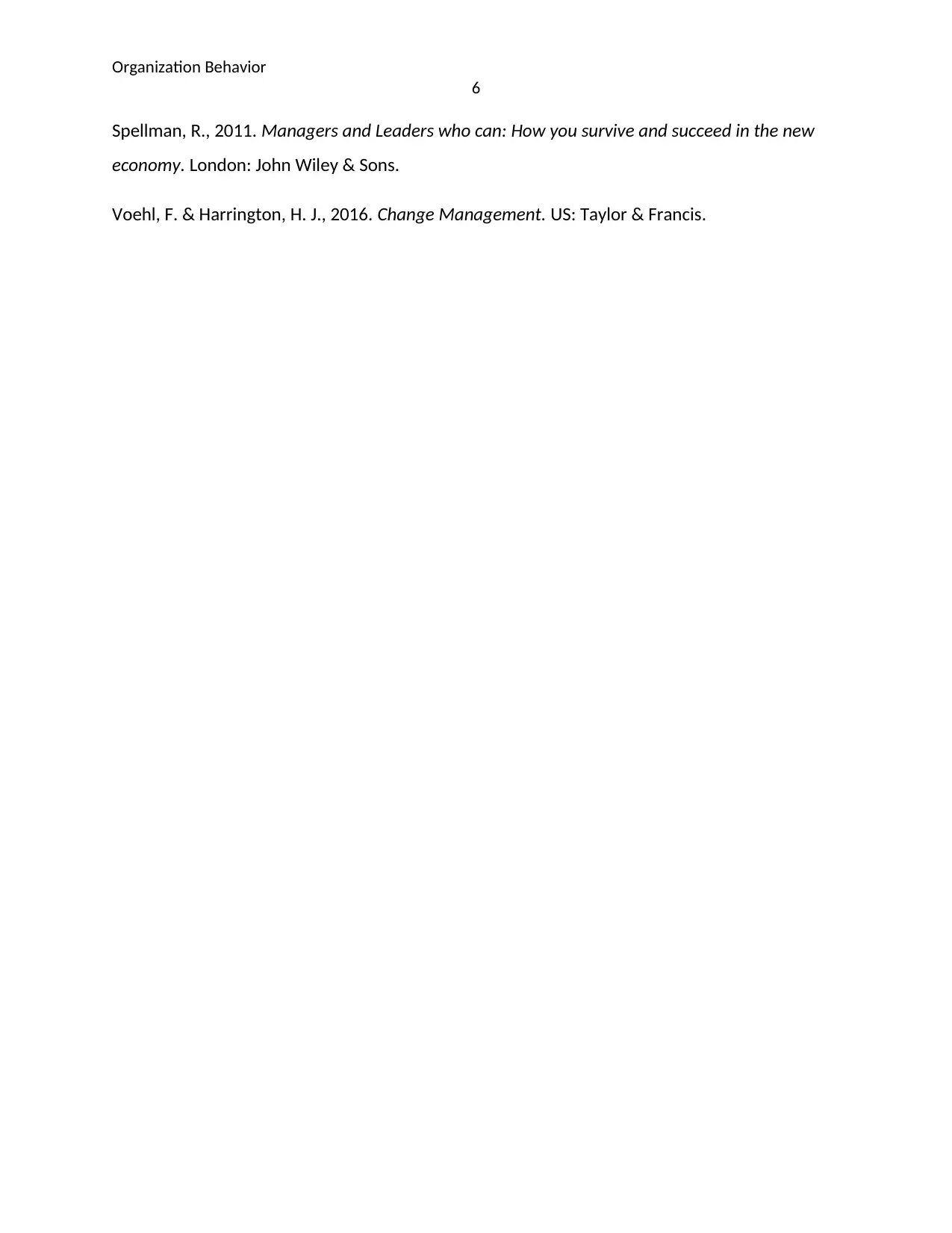
Organization Behavior
6
Spellman, R., 2011. Managers and Leaders who can: How you survive and succeed in the new
economy. London: John Wiley & Sons.
Voehl, F. & Harrington, H. J., 2016. Change Management. US: Taylor & Francis.
6
Spellman, R., 2011. Managers and Leaders who can: How you survive and succeed in the new
economy. London: John Wiley & Sons.
Voehl, F. & Harrington, H. J., 2016. Change Management. US: Taylor & Francis.
⊘ This is a preview!⊘
Do you want full access?
Subscribe today to unlock all pages.

Trusted by 1+ million students worldwide
1 out of 6
Related Documents
Your All-in-One AI-Powered Toolkit for Academic Success.
+13062052269
info@desklib.com
Available 24*7 on WhatsApp / Email
![[object Object]](/_next/static/media/star-bottom.7253800d.svg)
Unlock your academic potential
Copyright © 2020–2025 A2Z Services. All Rights Reserved. Developed and managed by ZUCOL.





